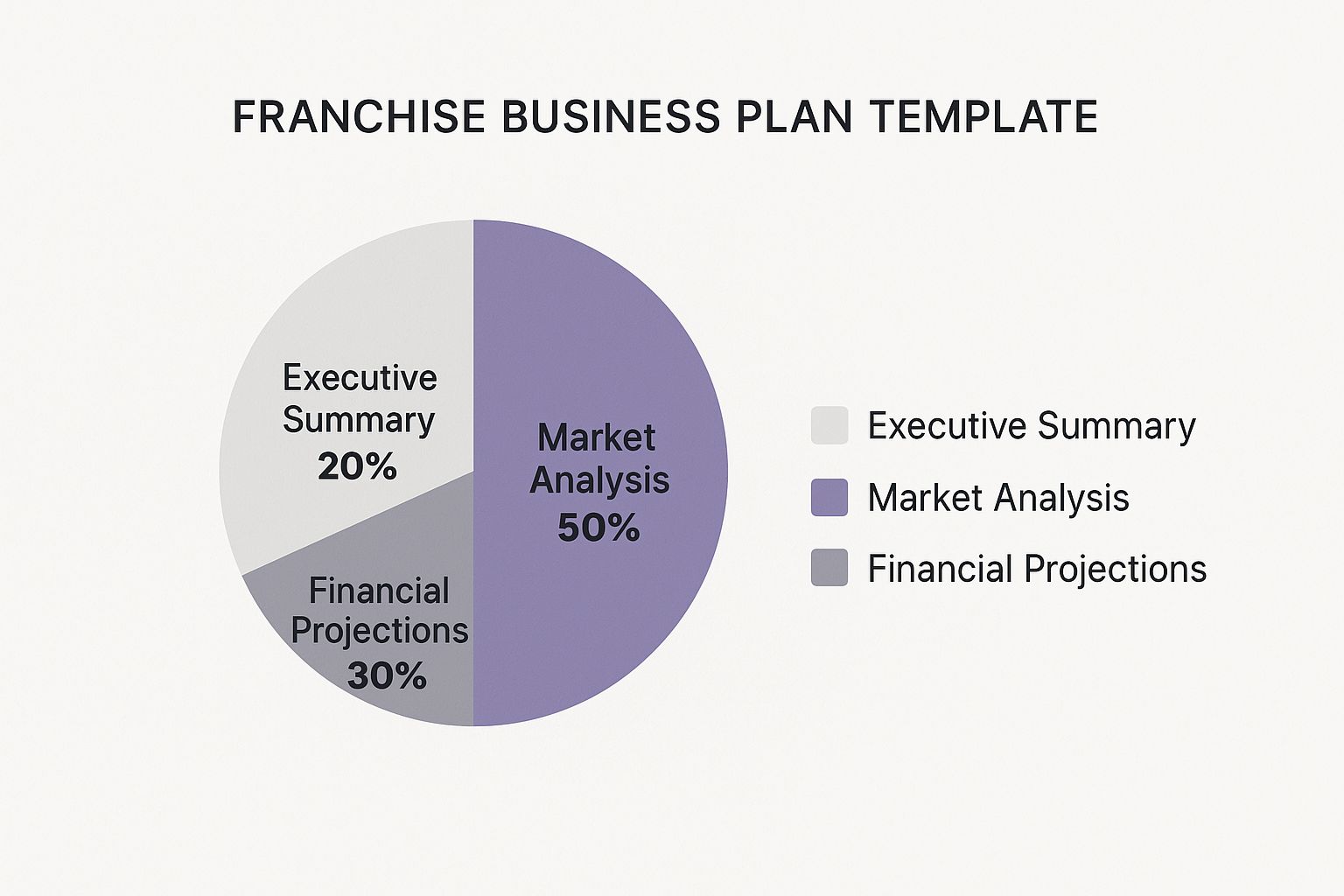

Build a winning strategy with our comprehensive franchise business plan template. Get expert guidance on financials, marketing, and operations to succeed.
Grabbing a generic business plan off the internet might feel like a smart first step, but for a franchise, it's a critical mistake. A standard plan completely misses the unique DNA of a franchise model, which is all about flawlessly executing a proven system—not inventing a new one.
The world of franchising plays by a different set of rules. A generic template simply doesn't have the slots for the non-negotiable details that franchisors and, more importantly, lenders need to see.
Think of it this way: a standard business plan is like creating a recipe from scratch. A franchise business plan is like being asked to perfectly replicate a famous chef's signature dish. You must follow their exact process, use their specific ingredients, and honor their presentation. No substitutions allowed.
This distinction is everything. I once saw a hopeful restaurant franchisee get rejected for a loan, despite having a beautifully written plan with solid market research. The problem? He completely glossed over the franchise agreement, the 4% royalty fee, and the mandatory 2% national marketing fund contribution. The lender wasn't looking at a plan to run a specific franchise; they were looking at a plan for a generic restaurant. It was an instant red flag.
A generic template won't even prompt you to include the details that make or break a franchise application. A proper franchise business plan template is built around these core components:
When you sit down to write, your time and focus need to be allocated correctly.

As you can see, a massive 50% of your effort should go into a deep, hyper-local market analysis. This is where you, the franchisee, add your unique value. This isn't just busywork; it's statistically tied to your odds of success. Entrepreneurs with a formal plan are 152% more likely to actually launch their business.
Even better, businesses that put their strategy on paper grow 30% faster and are far more successful at securing investment.
The following table breaks down exactly what's missing from a standard template and what you absolutely need to add for a franchise plan.
The key takeaway is that a franchise plan is less about invention and more about demonstrating your capability to execute a proven model within your specific local market.
For specialized businesses, this level of detail is even more critical. If you're looking to open a niche business like a martial arts dojo, the planning phase is where you win or lose. You can see just how detailed this gets in our complete guide on how to start a martial arts school.
Think of that franchise business plan template as your starting point, not the final destination. Let's dig deeper than just a simple checklist and really get into the 'why' behind each section. This is your guide to filling out that template in a way that turns it from a box-ticking exercise into a document that actually persuades people.

You're essentially telling two stories at once here. On one hand, you have to show you're committed to the franchisor's proven system. On the other, you need to prove you know your local area inside and out and can make this business a success right where you are. It’s a bit of a balancing act.
A franchise business plan is unique because it forces you to blend the franchisor's rigid requirements with the reality of your local market. I've seen countless franchisees succeed because they didn't just fill in the blanks; they customized their plan heavily to reflect local demographics, competition, and realistic financial projections.
Your Executive Summary is more than a quick intro—it's your elevator pitch on paper. It has to grab the reader, whether that’s the franchisor or a loan officer, from the very first line. This is no place for generic mission statements.
You need to blend your personal ambition with the power of the brand you're buying into. Why are you the perfect person to fly their flag in your town?
Treat it like a movie trailer. It needs to be exciting enough to make them want to watch the whole film.
Key Takeaway: The best executive summaries mix personal passion with hard data. They don't just answer "what" you plan to do, but "why" you're the only person who can pull it off.
If you're new to this whole process, getting the basic structure down is crucial. For a broader look at the core components of any solid plan, our guide on how to write a business plan is a great resource.
People often treat this section like a dry legal filing. And yes, you need to include your legal structure (LLC, Sole Proprietorship, etc.), but its real value is in telling the story of your specific business.
This is where you explain why you chose this franchise over all the others. Were you a customer who fell in love with the brand? Does your professional background line up perfectly with what it takes to run this business?
A former gym manager opening a fitness franchise, for instance, has a much more powerful story than someone with zero industry experience. In the same way, someone looking to open one of the many martial arts franchises (https://www.martialytics.com/best-software-for-martial-arts/martial-arts-franchises) should absolutely lean into their personal history with martial arts or their experience managing a similar kind of club.
The franchisor has already handled the big-picture, national market analysis. Your mission is to bring it right down to your own neighborhood. This is where you prove you’ve done more than just skim the Franchise Disclosure Document (FDD).
Generic stats about national industry growth are worthless here. A lender doesn't care about a competitor on the other side of the country; they want to know about the one on the other side of town.
Your hyper-local deep dive should cover:
By focusing on these nitty-gritty details, you stop being just another applicant and become a strategic local partner. You’re showing them you have a real, boots-on-the-ground understanding of the community you plan to serve—and that’s exactly what franchisors and lenders need to see.
Alright, this is where the rubber meets the road. Your franchise business plan moves from big-picture vision to the nitty-gritty of daily execution. Lenders and franchisors have seen plenty of enthusiasm; now they need to see that you can handle the day-to-day grind and run their proven system exactly as designed.
This is your chance to prove you’re a capable operator, not just a hopeful investor.

Here, you'll lay out the "how." How will you staff the place? How will you manage inventory? How will you make absolutely certain that every single customer gets the high-quality experience the brand is famous for? Your plan needs to show you’ve thought through every operational detail.
First things first: you have to sell yourself and your key players. This is no time for humility. The goal is to draw a direct line from your team's past experience to the specific skills needed to make this franchise a success.
Did your proposed manager spend five years in a high-volume retail setting? Don't just say that. Highlight their experience juggling staff schedules during the holiday rush and managing inventory like a hawk. Is your background in B2B sales? Frame that as a core strength in building local client relationships—perfect for a service-based franchise.
For instance, if you're pitching for a fast-food franchise, you’d want to spotlight experience with:
This kind of detail builds serious confidence. It shows you're not just buying yourself a job; you're building a professional, well-oiled machine.
You aren't inventing the wheel here, but you absolutely have to prove you can drive the car. Your operational plan should essentially mirror the franchisor's own playbook, but customized with the specific details of your location, your market, and your team.
This is where you translate the franchise manual into a concrete, day-by-day action plan. Think through a typical Tuesday. What are the opening procedures? Who’s handling the mid-day inventory check? What do the closing duties look like, step-by-step?
A Critical Point: Lenders see a detailed operational plan as a sign of reduced risk. It proves you understand that success in franchising comes from disciplined execution, not from reinventing the wheel. A sloppy operations section suggests you might go rogue, which is a franchisee's cardinal sin.
Getting this right is non-negotiable. For those looking to really nail this down, our guide on how to improve your operational efficiency offers expert tips that can be applied to any franchise model.
Beyond the daily workflow, your plan needs to address three core pillars: staffing, supply chain, and quality control. Each one must align perfectly with the franchisor’s requirements.
1. Your Staffing Model
A simple headcount won't cut it. You need to detail the roles, responsibilities, and even a sample weekly schedule. A staffing model for a B2B service franchise with a team of mobile technicians is worlds away from a quick-service restaurant.
2. Supply Chain Management
Franchises are built on consistency, and that starts with the supply chain. Here, you must list the franchisor's approved vendors for all key supplies—from raw ingredients to branded packaging. You also need to describe your inventory management process. How often will you order? How will you track stock levels to prevent shortages or spoilage?
3. Quality Control Measures
Finally, outline exactly how you will enforce the brand's quality standards. This covers everything from customer service scripts and food prep checklists to store cleanliness schedules. Mentioning specific tools, like using the franchisor's required Point of Sale (POS) system to track performance metrics, adds a powerful layer of credibility to your plan.
The franchisor handles the big-picture branding and national ad campaigns, which is a massive leg up. But don't get it twisted: your franchise's success or failure will be decided on the streets of your own town.
Winning over your local community is 100% on you, and it all starts with a rock-solid, hyper-local marketing plan.
This is the part of your business plan where you prove to lenders you get it. You’re not just opening another link in a chain; you're weaving your business into the fabric of a neighborhood. A generic, copy-paste marketing strategy just won't cut it. You have to show you've done your homework on the local scene and have a clear, actionable plan to become the go-to choice in your territory.
Before you can sell anything, you have to know exactly who you’re talking to. Sure, the franchisor might give you some broad customer profiles, but your job is to zoom in—way in. It's time to build detailed customer personas that reflect the actual people living and working within a five-mile radius of your front door.
Think about the unique flavor of your specific territory. A tutoring franchise, for instance, needs a completely different playbook depending on the neighborhood.
Your plan needs to prove you've moved beyond generalities and have a real strategy for connecting with the Sarahs and Davids in your specific area.
Your grand opening isn’t just a party with a big pair of scissors. It’s your single biggest marketing opportunity to make a massive splash. Your business plan needs to lay out a multi-channel blitz designed to build maximum buzz in the weeks leading up to launch. Think of it as a coordinated campaign, not just a one-day event.
Your grand opening sets the tone for your business’s entire lifecycle. A well-executed launch creates momentum that can carry you through the crucial first six months. A weak one forces you to play catch-up from day one.
A powerful grand opening strategy in your business plan might look something like this:
The grand opening buzz will eventually fade. That’s why your plan must detail your ongoing marketing and sales strategy for not just getting customers, but keeping them. This is what shows lenders you have a long-term vision.
Focus on tactics that truly embed your franchise into the community. For a home services franchise, this means going way beyond just placing an ad in the local paper. Your plan should outline specific, recurring activities that make you a neighborhood fixture.
By detailing these hyper-local strategies, you prove to lenders and the franchisor that you’re not just riding the brand's coattails. You have a concrete, intelligent plan to win your specific corner of the world.
Alright, let's get down to the brass tacks. This is where your franchise plan goes from a great idea to a bankable business. The numbers you lay out here aren't just wishful thinking; they are the foundation that proves your venture is viable. Lenders and franchisors need to see a realistic, well-researched path to profitability. This is how you show them you’ve done the hard work and truly understand the costs and opportunities ahead.

Franchising is a massive economic driver, with over 780,000 establishments across the U.S. alone. The industry's steady 2.6% annual growth rate is built on one simple thing: proven models that work. Your job is to show how you'll make that model work in your specific location.
Your goal here is to craft a set of financial documents that are both optimistic and deeply rooted in reality. Every number needs a backup.
Hope is not a financial strategy. The quickest way to get a "no" is to present numbers pulled from thin air. Your projections must be built by blending the franchisor's data with your own boots-on-the-ground research.
Your first stop is the Franchise Disclosure Document (FDD). This is your treasure map. Zero in on Item 7, which breaks down the estimated initial investment. Then, if the franchisor provides it, dive into Item 19 for financial performance representations from other franchisees.
But don't stop there. The FDD gives you averages, not your specific reality. You have to layer in local data to make the plan truly yours:
This combination of franchisor data and local intelligence is what turns a generic template into a plan that gets funded.
Your financials will center on four key documents. Each tells a different part of your story, and together they create a complete picture of your franchise's potential. Before you dive in, remember that understanding your funding options is key. You can find a complete guide on how to finance a franchise to explore those strategies in detail.
Before you even think about revenue, you need an exhaustive list of every single dollar you'll spend just to open the doors. This table gives you a framework for the kind of one-time expenses you'll need to budget for.
Use this as a starting point, but dig in and get real quotes for your specific situation. The more detailed you are, the more credible your plan becomes.
1. Pro Forma Income Statement (P&L)
This projects your revenue, expenses, and profitability over the first three to five years. Be conservative here, especially in year one. Show a realistic ramp-up as you build your customer base. Crucially, don't forget to include franchise-specific costs like ongoing royalties and marketing fund contributions.
2. Cash Flow Statement
Honestly, this might be the most important document for any new business. It tracks the actual cash moving in and out of your bank account each month. Profit on paper doesn't pay the bills; cash does. This statement proves you have enough working capital to survive the lean early months before you're in the black.
Pro Tip: Lenders love to see a "contingency" line item in your startup costs, usually 10-15% of your total budget. It shows you're a serious planner who is prepared for the inevitable curveballs, instantly boosting your credibility.
3. Pro Forma Balance Sheet
This is a snapshot of your business's financial health at a moment in time, showing your assets (what you own) and liabilities (what you owe). For a new franchise, it clearly shows how the startup funding will be used to acquire assets and how your own equity stake will look from day one.
The final piece of the financial puzzle is your breakeven analysis. This is the magic number—the exact sales volume you need to hit for your total revenue to equal your total costs. From that point on, you're officially making money.
This simple calculation powerfully answers a lender’s biggest question: "When will this business start paying for itself?" Presenting a clear, logical breakeven point demonstrates a masterful grasp of your business's economics and puts a final, convincing stamp on your financial projections.
Once you get deep into writing your franchise business plan, you’ll inevitably hit a few tricky spots. These are the questions that pop up for almost every aspiring franchisee. Having clear, confident answers is what separates a good plan from a great one. Let’s tackle some of the most common ones I hear.
Think of the franchisor's template as the skeleton. It’s a solid, necessary structure, but it’s not the whole body. Your job is to add the muscle and skin—the local research and personal details that bring it to life. While you absolutely need to follow the core operational framework, lenders expect you to make it your own.
They need to see that you've done your homework, especially in two key areas:
Beyond that, the sections about your personal background and management team are all you. Customization proves you’re a serious, hands-on partner, not just someone buying a job.
Without a doubt, the single most damaging mistake is creating wildly optimistic financial projections that aren't backed by solid, verifiable data.
It's tempting to just copy the "best-case scenario" numbers from the Franchise Disclosure Document (FDD), but this is a massive red flag for both franchisors and lenders. It immediately signals that you haven't done your due diligence.
Always be conservative with your revenue estimates and realistic about your expenses. A well-reasoned, slightly cautious plan is far more credible and impressive than a pie-in-the-sky forecast that crumbles under the slightest scrutiny.
Your plan’s integrity hinges on its believability. Show your work, cite your sources for local data, and build a case that can withstand tough questions.
A consultant can be a fantastic resource for polishing and refining your plan, but you absolutely must be the primary author. Don't outsource the core thinking.
Remember, lenders and franchisors are investing in you and your ability to run the business, not the consultant. They need to see your personal understanding, your strategy, and your vision shining through.
Here’s the best approach: write the entire plan yourself first. Get all your research and ideas down. Then, bring in a consultant to review it, double-check your financial models, and offer constructive feedback. The passion has to come from you. It’s surprisingly easy to spot a plan that lacks the owner’s personal touch.
When Item 19 of the FDD—the section on Financial Performance Representations—is left blank, it's time to put on your detective hat. You’re not flying blind; you just need to gather your own intel.
At Martialytics, we understand the discipline and planning it takes to run a successful school. Our management software is designed to handle the administrative load, so you can focus on building your business and community. See how Martialytics can support your new martial arts franchise.


No credit card required. No lock in contracts. Start your 30-day free trial to see immediate improvements.

Book your free demo with one of the co-founders of Martialytics, Brad or Allen, depending on your time-zone.
We'll do this on Zoom video conferencing software for awesome screen sharing so please make sure you have the app or are good to go before the time starts.